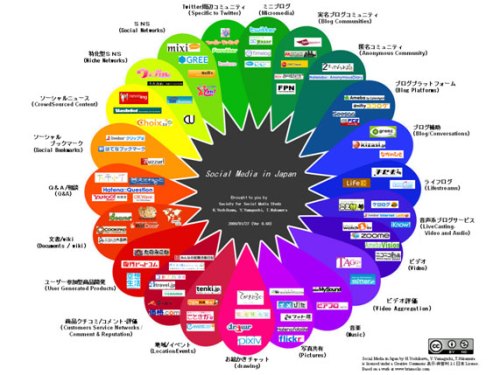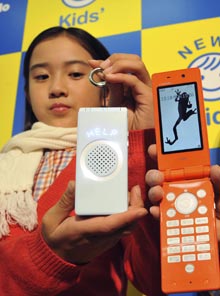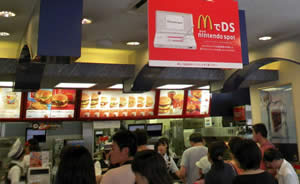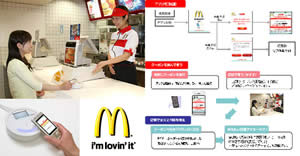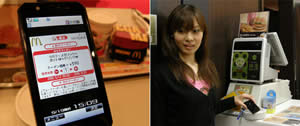So is finally time to talk about social media in Japan. First I think is adequate to point some unique characteristics of Japans Social Media Market.
Japan has about 120 million residents and 2/3 of it are connected to the internet, this large penetration of the internet in society hasn’t invest much on it, only half of Japan’s 4000 companies spend more than $100k on the internet at all and there are more mobile internet users than wired in Japan.
Is also important to notice that Social Media scene in Japan is totally isolated. Mostly because of language and cultural barriers.
Wikipedia defines Social Media as Internet- and mobile-based tools for sharing and discussing information among human beings. The image below is a brief history of social media penetration in Japan.
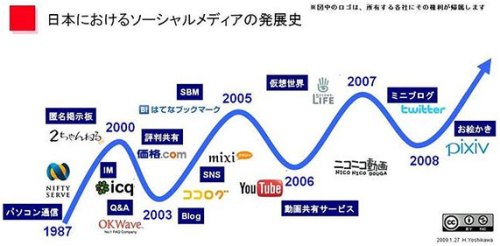
As I said before Television is still the major media in Japan, but the world of the Internet is a challenge in this sense, because advertising on the Internet is still small, and advertising space there in most cases is cheap. Japan’s online advertising is taking steps to become a great media between 2004 and 2006 it grew from 3% to 6% of all advertising investments as shown by eMarketer.
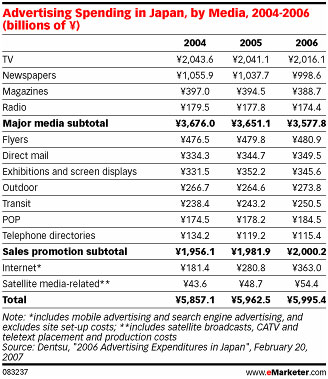
And analyzing the 2007 Advertising expenditures in Japan Internet ads rose faster than any other media. The Internet media investment grew 24%. from 2006 to 2007, and for the first time, exceeded expenditures on magazine advertising. It is a big step but if was responsible for only 8,6% for the total expenditures, while TV was 28,5% and Newspapers 13,5%. Click here for the full article – Dentsu: 2007 Advertising Expenditures in Japan.
Through a survey from Goo Research is possible to see which are the most popular Social Network Systems. Thank you very much for What Japan Thinks for translating this research and many other surveys
Are you currently using a Social Networking Service?
| Currently using | 31.5% |
| Used to use | 10.5% |
| Never used | 43.1% |
| Don’t know what SNS is | 14.8% |
Which Social Networking Service are you currently using?
| Votes | Percentage | |
| mixi | 296 | 86.0% |
| GREE | 36 | 10.5% |
| Yahoo! Days | 26 | 7.6% |
| MySpace | 19 | 5.5% |
| Rakuten Ichiba Links | 9 | 2.6% |
| freeml | 6 | 1.8% |
| livedoor Furupa | 4 | 1.2% |
| CURURU | 4 | 1.2% |
| So-net SNS | 3 | 0.9% |
| 1 | 0.3% | |
| CyWorld | 0 | 0.0% |
| JOCOSO | 0 | 0.0% |
| SayClub | 0 | 0.0% |
| Other | 57 | 17.1% |
Social Networking has steadily increased in popularity in Japan they provide platforms for the Japanese to socialize interact and communicate online. It is said that the Social Networks offers a safe environment for self-expression and social development.

Mixi is Japans top Social Network, it is completely build for Japanese people and culture, hardly Facebook, MySpace or Orkut will be able overcome Mixis popularity. In June 2008, Mixi accounted for 12.4 million, or 41%, of the 31 million unique visitors for all social networking sites in Japan. The biggest problem for the penetration of other Social Network ar the language barriers, most Japanese know that Facebook and MySpace have Japanese-language sites.
Another advantage Mixi has is it Mobile platform, most Japanese accesses the internet and engages in social networking via their cell phones.
Mixis revenue comes from advertising. Yahoo! Japan had a 45.1% share of total ad impressions with 13.3 billion impressions, followed by Japan’s Mixi with an 11.3% market share and 3.3 billion ad impressions.
For now this is enough I will try to next week write a part two: focused more on blogging and Micro-blogging and mobile advertising.
Also I found a great Mandala with the Social Media Scene in Japan. Click Here for the Full Size
